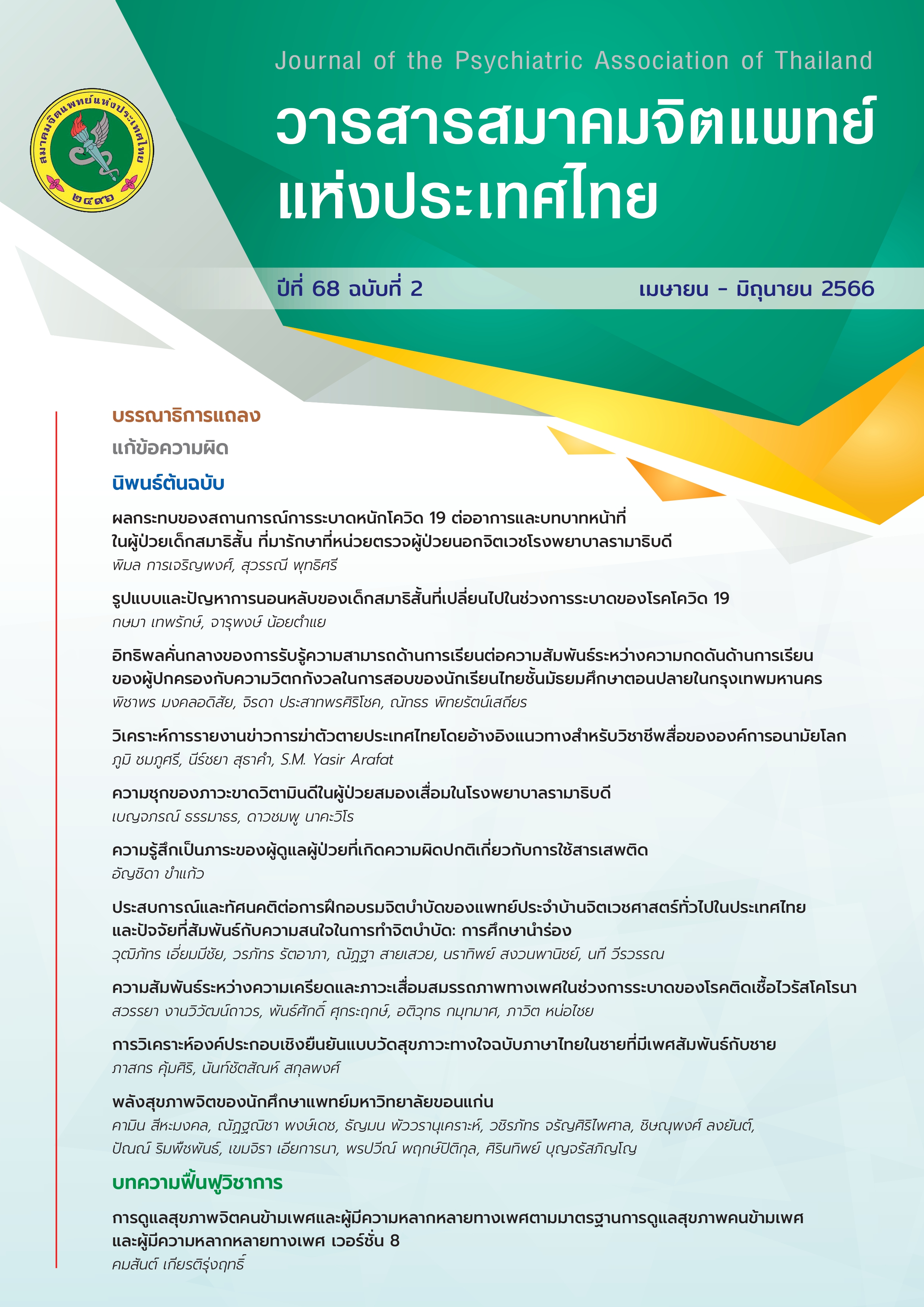Correlation Between Stress and Sexual Dysfunction During COVID-19 Pandemic
Main Article Content
Abstract
Objective: To study the correlation between stress and sexual dysfunction during COVID-19 pandemic.
Methods: A sample of Thai people aged 20-59 who completed an online survey through social media via convenience sampling technique from January 15 – 17, 2021. Participants self-reported their stress level and screened for sexual dysfunction using the Suanprung stress questionnaire and Arizona Sexual Experience Scale in their Thai versions. The chi-square test and binary logistic regression analyzed the correlation between stress and sexual dysfunction with statistical significance at the level of 0.10.
Results: During the COVID-19 epidemic, the prevalence of high and very high stress levels was 65%. The prevalence of sexual dysfunction was 2%. Factors associated with stress were sexual orientation, age, education co-morbidities, income, and expenses. The factors associated with sexual dysfunction were gender, marital status, and stress. Binary logistic regression showed people with severe and very severe stress were twice as likely to have sexual dysfunction as those with normal stress levels, with OR = 1.086 (95% CI = 0.404-2.922).
Conclusion: The World Health Organization declared that COVID-19 is a pandemic. Currently, data on sexual medicine and stress during the COVID-19 outbreak in Thailand are limited. The COVID-19 outbreak affects health, business, and economy and causes stress and sexual dysfunction. These problems should be addressed holistically.
Article Details

This work is licensed under a Creative Commons Attribution-NonCommercial-NoDerivatives 4.0 International License.
Articles submitted for consideration must not have been previously published or accepted for publication in any other journal, and must not be under review by any other journal.
References
WHO.Coronavirus disease 2019 (COVID-19) [Internet];2020 [cited 2020 May 10]. Available from: https://www.who.int/docs/ default-source/coronaviruse/situation-reports/20200311- sitrep-51-covid-19.pdf?sfvrsn¼1ba62e57_10.
Thai PBS news. COVID-19 epidemic situation[Internet]; 2020 [cited 2020 May 10]. Available from: https://news.thaipbs.or.th/search?q=%E0%B9%82%E0%B8%84%E0%B8%A7%E0%B8%B4%E0%B8%94-19
Duan L, Zhu G. Psychological intervention for people affected by the COVID-19 epidemic. Lancet Psychiatry 2020;7:300-2.
Zhang J, Wu J, Li Y, Zhou Y, Zhao R, Shi Y, Chen J, et al. Influence factors of sexual activity for internal migrants in China. Sex Med 2018;6:97-107.
Li W, Li G, Xin C, Wang Y, Yang S. Challenges in the practice of sexual medicine in the time of COVID-19 in China. J Sex Med 2020;17:1225-8.
Butler L. Challenges in the practice of sexual medicine in the time of COVID-19 in the United Kingdom. J Sex Med 2020;17(7):1229-36.
Schiavi MC, Spina V, Zullo MA, Luffarelli P, Rago R, Palazzetti P. Love in the time of COVID-19: Sexual function and quality of life analysis during the social distancing measures in a group of Italian reproductive-age women. J Sex Med 2020;17:1407-13.
Ebrahim S. Sexual intercourse and risk of ischemic stroke and coronary heart disease: the Caerphilly study. J Epidemiol Community Health 2002;56(2):99-102.
Wright H, Jenks RA. Sex on the Brain! Associations between sexual activity and cognitive function in older age. Age Ageing 2016;45(3):313-7.
Lê MG, Bachelot A, Hill C. Characteristics of reproductive life and risk of breast cancer in a case-control study of young nulliparous women. J Clin Epidemiol 1989;42(12):1227-33.
Krejcie RV, Morgan DW. Determining sample size for research activities. Educational and Psychological Measurement 1970;30:607-10.
Mustafa N. Psychological stress and associated factors during the coronavirus disease (COVID-19). Int J Sci Res 2020;10(4):12-18.
Lai J, Ma S, Wang Y, Liu Z, Hu S, Kang L, Lai J, et al. Factors associated with mental health outcomes among health care workers exposed to coronavirus disease 2019. JAMA Netw Open 2020;3(3):e203976.
Czeisler MÉ, Lane RI, Petrosky E. Mental health substance use and suicidal ideation during the COVID-19 pandemic — United States, June 24–30, 2020. MMWR Morb Mortal Wkly Rep 2020;69:1049–57.
Kongkanand A. Prevalence of erectile dysfunction in Thailand. Thai Erectile Dysfunction Epidemiological Study Group. International Journal of Andrology 2000;23(2):77-80.
Hatzimouratidis K. Guidelines on male sexual dysfunction: Erectile dysfunction and premature ejaculation. European Urology 2010;57(5):804-14.
New York Post. COVID-19's latest side effect hits below the belt [Internet]; 2020 [cited 2020 May 10]. Available from: https://nypost.com/tag/erectile-dysfunction/.
Pennanen-Iire C, Prereira-Lourenço M, Padoa A. Sexual health implications of COVID-19 pandemic. Sex Med Rev 2021;9:3-14.
Galanakis M, Kallianta KC, Liakopoulou D, Chrousoes G. The association between stress and sexual dysfunctionality in men and women: A Systematic Review. Psychology 2021;6:1888-92.
Huang C, Huang L, Wang Y, Li Y, Zhong J, Cao B, Zhang D, et al. 6-month consequences of COVID-19 in patients discharged from hospital: a cohort study. Lancet 2021;391:220-32.
Yafi FA, Jenkis L, Albersen M, Corona G, Goldfarb S, Parish S, Salonia A, et al. Erectile dysfunction. Nat Rev Dis Primers 2016;2:16003.
Mori T, Hotta Y, Nakamura D, Yahagi R, Kataoka T, Maeda Y, Kimura K. The mechanisms of stress-induced erectile dysfunction: a focus on regulators of contraction and relaxation in the corpus cavernosum by using a rat model of water immersion-restraint stress. J Sex Med 2018;15(7):S139.


